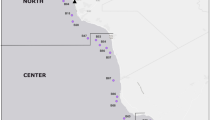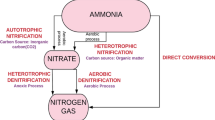Abstract
The study reported the upflow anaerobic sludge blanket (UASB) reactor performance in treating wastewater containing trichloroethylene (TCE) and characterized variations of bacteria composition and structure by changing the pH from 6.0 to 8.0. A slightly acidic environment (pH < 7.0) had a greater impact on the TCE removal. Illumina pyrosequencing was applied to investigate the bacterial community changes in response to pH shifts. The results demonstrated that pH greatly influenced the dominance and presence of specific populations. The potential TCE degradation pathway in the UASB reactor was proposed. Importantly, the genus Dehalobacter which was capable of reductively dechlorinating TCE was detected, and it was not found at pH of 6.0, which presumably is the reason why the removal efficiency of TCE was the lowest (80.73 %). Through Pearson correlation analyses, the relative abundance of Dehalobacter positively correlated with TCE removal efficiency (R = 0.912). However, the relative abundance of Lactococcus negatively correlated with TCE removal efficiency according to the results from Pearson correlation analyses and redundancy analysis (RDA).






Similar content being viewed by others
References
ATSDR (2014) Trichloroethylene (CAS#79-01-6) Division of Toxicology toxFAQsTM. Agency for Toxic Substances and Disease Registry, Atlanta, GA, USA
Atuanya EI, Chakrabarti T (2003) Biotreatability and kinetics of UASB reactor to mixtures of chlorophenol pollutants. Environ Monit Assess 83:283–294
AWWA (1998) Standard methods for the examination of water and wastewater. Washington, DC Standard Methods for the Examination of Water and Wastewater 20
Bae HS, Moe WM, Yan J, Tiago I, da Costa MS, Rainey FA (2006) Propionicicella superfundia gen. nov., sp. nov., a chlorosolvent-tolerant propionate-forming, facultative anaerobic bacterium isolated from contaminated groundwater. Syst Appl Microbiol 29:404–413
Castelló E, Santos CG, Iglesias T, Paolino G, Wenzel J, Borzacconi L, Etchebehere C (2009) Feasibility of biohydrogen production from cheese whey using a UASB reactor: links between microbial community and reactor performance. Int J Hydrogen Energy 34:5674–5682
Choi K, Lee W (2012) Enhanced degradation of trichloroethylene in nano-scale zero-valent iron Fenton system with Cu(II). J Hazard Mater 211–212:146–153
Ergüder TH, Tezel U, Güven E, Demirer GN (2001) Anaerobic biotransformation and methane generation potential of cheese whey in batch and UASB reactors. Waste Manag 21:643–650
Holliger C, Hahn D, Harmsen H, Ludwig W, Schumacher W, Tindall B, Zehnder AJ (1998) Dehalobacter restrictus gen. nov. and sp. nov., a strictly anaerobic bacterium that reductively dechlorinates tetra- and trichloroethene in an anaerobic respiration. Arch Microbiol 169:313–321
Horiuchi J, Shimizu T, Tada K, Kanno T, Kobayashi M (2002) Selective production of organic acids in anaerobic acid reactor by pH control. Bioresour Technol 82:209–213
Hug LA, Beiko RG, Rowe AR, Richardson RE, Edwards EA (2012) Comparative metagenomics of three Dehalococcoides-containing enrichment cultures: the role of the non-dechlorinating community. BMC Genomics 13:327
Krakat N, Schmidt S, Scherer P (2011) Potential impact of process parameters upon the bacterial diversity in the mesophilic anaerobic digestion of beet silage. Bioresour Technol 102:5692–5701
Lee M (2001) Characterization of a trichloroethene-dechlorinating mixed culture. Dissertation, Univeristy of Delaware
Leps J, Smilauer P (2003) Multivariate analysis of ecological data using CANOCO. Cambridge University Press, Cambridge, UK
Liang DW, Zhang T, Fang HH (2007) Anaerobic degradation of dimethyl phthalate in wastewater in a UASB reactor. Water Res 41:2879–2884
Lohse M, Bolger AM, Nagel A, Fernie AR, Lunn JE, Stitt M, Usadel B (2012) RobiNA: a user-friendly, integrated software solution for RNA-Seq-based transcriptomics. Nucleic Acids Res 40:W622
Lü F, Shao LM, Bru V, Godon JJ, He PJ (2009) Synergetic effect of pH and biochemical components on bacterial diversity during mesophilic anaerobic fermentation of biomass-origin waste. J Appl Microbiol 106:580–591
Magoc T, Salzberg S (2011) FLASH: fast length adjustment of short reads to improve genome assemblies. Bioinformatics 27:2957–2963
Majumder PS, Gupta SK (2008) Degradation of 4-chlorophenol in UASB reactor under methanogenic conditions. Bioresour Technol 99:4169–4177
Masoud W, Takamiya M, Vogensen FK, Lillevang S, Al-Soud WA, Sørensen SJ, Jakobsen M (2011) Characterization of bacterial populations in Danish raw milk cheeses made with different starter cultures by denaturating gradient gel electrophoresis and pyrosequencing. Int Dairy J 21:142–148
Mitra S, Gupta SK (2013) Biodegradation of trichloroethylene in anaerobic hybrid reactor. Environ Prog Sustain 32:1055–1060
Miura Y, Watanabe Y, Okabe S (2007) Significance of Chloroflexi in performance of submerged membrane bioreactors (MBR) treating municipal wastewater. Environ Sci Technol 41:7787–7794
Mohn WW, Tiedje JM (1992) Microbial reductive dehalogenation. Microbiol Rev 56:482–507
Ozdemir C, Dursun S, Karatas M, Sen N, Sahinkaya S (2007) Removal of trichloroethylene (TCE) in up flow anaerobic sludge blanket reactors (UASB). Biotechnol Biotechnol Equip 21:107–112
Pikuta EV, Hoover RB, Bej AK, Marsic D, Whitman WB, Krader PE, Tang J (2006) Trichococcus patagoniensis sp. nov., a facultative anaerobe that grows at -5°C, isolated from penguin guano in Chilean Patagonia. Int J Syst Evol Microbiol 56:2055–2062
Schloss PD, Gevers D, Westcott SL (2011) Reducing the effects of PCR amplification and sequencing artifacts on 16S rRNA-based studies. PLoS ONE 6:e27310
Shukla AK, Vishwakarma P, Singh RS, Upadhyay SN, Dubey SK (2010) Bio-filtration of trichloroethylene using diazotrophic bacterial community. Bioresour Technol 101:2126–2133
Shukla AK, Vishwakarma P, Upadhyay SN, Tripathi AK, Prasana HC, Dubey SK (2009) Biodegradation of trichloroethylene (TCE) by methanotrophic community. Bioresour Technol 100:2469–2474
Siggins A, Enright AM, O’Flaherty V (2011a) Low-temperature (7°C) anaerobic treatment of a trichloroethylene-contaminated wastewater: Microbial community development. Water Res 45:4035–4046
Siggins A, Enright AM, O’Flaherty V (2011b) Temperature dependent (37-15°C) anaerobic digestion of a trichloroethylene-contaminated wastewater. Bioresour Technol 102:7645–7656
Sogin ML, Morrison HG, Huber JA, Welch DM, Huse SM, Neal PR, Arrieta JM, Herndl GJ (2006) Microbial diversity in the deep sea and the underexplored ‘rare biosphere’. Proc Natl Acad Sci U S A 103:12115–12120
Tartakovsky B, Manuel MF, Beaumier D, Greer CW, Guiot SR (2001) Enhanced selection of an anaerobic pentachlorophenol-degrading consortium. Biotechnol Bioeng 73:476–483
Van Haandel AC, Lettinga G (1994) Anaerobic sewage treatment: a practical guide for regions with a hot climate. Wiley, Chichester, England
Wang Q, Garrity GM, Tiedje JM, Cole JR (2007) Naive Bayesian classifier for rapid assignment of rRNA sequences into the new bacterial taxonomy. Appl Environ Microbiol 73:5261–5267
Watson RE, Jacobson CF, Williams AL, Howard WB, DeSesso JM (2006) Trichloroethylene-contaminated drinking water and congenital heart defects: a critical analysis of the literature. Reprod Toxicol 21:117–147
Yadvika S, Sreekrishnan TR, Kohli S, Rana V (2004) Enhancement of biogas production from solid substrates using different techniques—a review. Bioresour Technol 95:1–10
Ye NF, Lü F, Shao LM, Godon JJ, He PJ (2007) Bacterial community dynamics and product distribution during pH-adjusted fermentation of vegetable wastes. J Appl Microbiol 103:1055–1065
Zehnder AJB, Ingvorsen K, Marti T (1982) Microbiology of methane bacteria. In: Hughes DE, Stafford DA, Wheatley BI, Baader W, Lettinga G, Nyns EJ, Verstraete W (eds) Anaerobic digestion. Elsevier Biomedical Press, Amsterdam, pp 45–68
Zhang Y, Liu Y, Hu M, Jiang Z (2014) Acclimation of the trichloroethylene anaerobic degradation granular sludge and the degradation characteristics in an upflow anaerobic sludge blanket reactor. Water Sci Technol 69:120–127
Zhang Y, Wang X, Hu M, Li P (2015a) Effect of hydraulic retention time (HRT) on the biodegradation of trichloroethylene wastewater and anaerobic bacterial community in the UASB reactor. Appl Microbiol Biotechnol 99:1977–1987
Zhang Y, Hu M, Li P, Wang X, Meng Q (2015b) Trichloroethylene removal and bacterial variations in the up-flow anaerobic sludge blanket reactor in response to temperature shifts. Appl Microbiol Biotechnol 99:6091–6102
Zhuang P, Pavlostathis SG (1995) Effect of temperature, pH and electron donor on the microbial reductive dechlorination of chloroalkenes. Chemosphere 31:3537–3548
Zielińska M, Cydzik-Kwiatkowska A, Zieliński M, Dębowski M (2013) Impact of temperature, microwave radiation and organic loading rate on methanogenic community and biogas production during fermentation of dairy wastewater. Bioresour Technol 129:308–314
Acknowledgments
This work was supported by University Science and Technology Innovation Team Construction Projects of Heilongjiang Province (2013TD003) and Shanghai Tongji Gao Tingyao Environmental Science & Technology Development Foundation (STGEF).
Conflict of interest
The authors declare that they have no competing interests.
Author information
Authors and Affiliations
Corresponding author
Rights and permissions
About this article
Cite this article
Zhang, Y., Hu, M., Li, P. et al. Analysis of trichloroethylene removal and bacterial community function based on pH-adjusted in an upflow anaerobic sludge blanket reactor. Appl Microbiol Biotechnol 99, 9289–9297 (2015). https://doi.org/10.1007/s00253-015-6800-1
Received:
Accepted:
Published:
Issue Date:
DOI: https://doi.org/10.1007/s00253-015-6800-1




